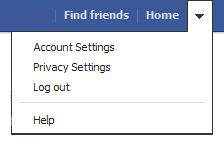 Apparently from Saturday you’ll have to switch to Facebook’s timeline.
Apparently from Saturday you’ll have to switch to Facebook’s timeline.
I’ve resisted it. I found it harder to find things on other people’s profile so I didn’t want to change my own but I finally gave in to the inevitable and updated my facebook page to timeline last weekend. I did some research, and the two things I knew I had to change were the cover image and my privacy settings. I also knew I needed to check which apps were connected to my facebook account and ensure that there was no frictionless sharing that I did not want.
1; The Cover Image
This is the large banner style image that is at the top of the page, your profile image is now set into the lower left of it.

I’m a bit leery of posting photos of myself online, I like my face well enough, but I’ve had a couple of minor stalker-ish issues in the past. So I choose my favourite image from my holiday last summer, of calm seas and boats at anchor. It was taken soon after dawn on a day with no wind in the middle of a sailing holiday. It goes with my profile picture – but that’s luck rather then good management. The overall impression is pleasing, but not particularly creative.
Facebook said that around half of my friends had switched – but not all of those had uploaded a new cover photo, so I suspect for some it hasn’t been a choice.
For a brilliant (and funny) riff on the whole cover photo concept, take a minute to check this out.
2; Privacy Settings
It’s one of my gripes about Facebook – the privacy settings aren’t that easy to find. But because facebook now pushes everything you do onto your timeline it’s important to find them and check your settings.
Look for the little arrow on the top right of the page, click on it and you’ll see a short menu which includes Privacy Settings.
 Once you have found it and clicked on privacy settings it is easy, easier than it has been, to control who can connect with you, and who can see and post to your timeline.
Once you have found it and clicked on privacy settings it is easy, easier than it has been, to control who can connect with you, and who can see and post to your timeline.
You will also need to go through your timeline and remove anything that you don’t want to be seen – some things that were buried in the past are now easier for your friends and contacts to browse to. You can remove items individually by clicking on the “edit or remove”button on the upper right of the image. I like the “micro control” this gives visitors to facebook.
It’s easier on timeline for someone to find old posts you made, to limit this to friends only click on “Limit the Audience for Past Posts” on the privacy settings post. They’ve made this step hard to reverse so be sure it’s what you want before saying yes. For me this was a no-brainer, I’ve never wanted to share publically on facebook so limiting who can see the history probably doesn’t change what non-friends can see – but I enabled it just to be sure.
You can also delete your posts from other people’s timeline – this could be important because you do not know their privacy settings, and it’s their settings that will apply to your post. Here’s how.
3; Frictionless Sharing
This is the concept that information from one place, or internet service is shared on facebook. It’s why you’re seeing what your colleague listens to on Spotify or what your brother has read on Washington Post. I don’t particularly want to know, and I definitely don’t want to share. So I haven’t enabled this sort of sharing. In fact I will not click through to articles from Washington Post because I don’t want this sort of cross-platform sharing.
When I set up timeline I checked which apps had access to my facebook account (via the privacy settings), it’s only two and neither of them post to facebook automatically. Which is good news for me – I won’t be spamming my friends.
So it’s done. I’m on timeline. It took me about fifteen minutes.
Others have become more concerned about the facebook security, in some cases to the point where they purge their profile regularly or delete it all together. My personal approach is that I don’t put anything there that isn’t more or less public, and I only connect to family and friends. I lock down the security fairly strongly (only friends can see my profile), and I check the site daily (OK not just for security reasons). I still think it’s a great tool – but everyone has to take responsibility for protecting their own data and being smart about what they share online. It’s public people.

 I am having a lot of fun playing on Pinterest, I probably visit it daily and add something each day. But there are a few things that annoy me.
I am having a lot of fun playing on Pinterest, I probably visit it daily and add something each day. But there are a few things that annoy me.


 This is the first time in two years I haven’t started my day looking at twitter.
This is the first time in two years I haven’t started my day looking at twitter.
 It sounds terrifically important, to say that something is “mission critical”, and the
It sounds terrifically important, to say that something is “mission critical”, and the 

